The Skitch Skateboard: An In-Depth Analysis
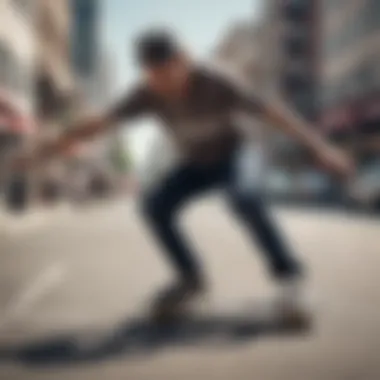
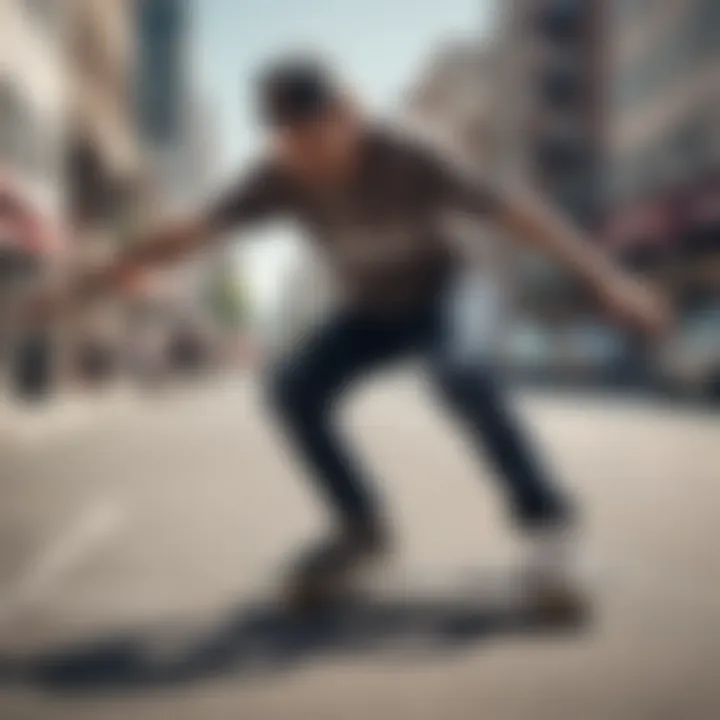
Intro
Skitching has become synonymous with the freewheeling spirit of skateboarding. The term itself whispers tales of daring maneuvers, where skaters hitch a ride on the back of moving vehicles for a swift thrill. This practice, while exhilarating, threads through a maze of history, safety conversations, and an engaging culture that resonates deeply with skateboarding enthusiasts everywhere.
Skating with a Purpose
Understanding the essence of skitching isn’t just about the rush; it’s about appreciating a broader community and acknowledging the skill that splashes vivid color on an otherwise monochrome view of skating. In this article, we will peel back the layers of skitching, from its historical roots to the contemporary debates surrounding its practice, examining both the thrilling highs and the chilling lows that skaters experience in this adventure.
The thought of hanging onto a vehicle, feeling the wind whip past, often ignites a spark of nostalgia for many seasoned skaters. Young blood joining the ranks of this subculture will find that skitching is not merely a reckless pastime, but rather a canvas for creative expression, requiring finesse and a sharp sense of timing.
Techniques and Skills
Essential Tricks for Beginners
For newcomers to the world of skitching, the initial foray into this high-octane activity can feel daunting. However, starting small can set the groundwork for a more confident and exhilarating skitching experience.
- Stance Mastery: A sound foundation in posture is key. Position your feet shoulder-width apart, with your dominant foot slightly angled back on the tail of the board. This should create a comfortable balance for any tricks.
- Hitching Basics: Begin with experimentation. Try skitching on stationary bikes or moving skateboards before transitioning to vehicles. This will give you a feel of how weight distribution plays a crucial role during the ride.
- Communicating with Drivers: It's important to never skitch without complying with a clear signal from the driver. Establishing a visual cue ensures that both parties are on the same page, reducing risks on the road.
Advanced Techniques for Pros
Once you’ve mastered the fundamental aspects, taking steps towards advanced techniques can enhance your skitching game:
- Carve and Lean: When you’re comfortable, practice leaning into the curves of the vehicle. This not only builds trust in your ability to control your board but also adds a thrilling twist to your ride.
- Speed Control: Knowing how to handle different speeds is paramount. Utilize your legs as shock absorbers to navigate sudden stops or acceleration.
- Team Feats: Consider practicing with fellow skaters. Stacking tricks together, like tandem skitching, adds a thriller factor and fosters a sense of camaraderie.
"Skitching is a dance with the urban landscape. It’s dialogue between the skater and the city, daring to flirt with speed and balance."
Skateboarding Culture
The Evolution of Skateboarding
The landscape of skateboarding has evolved dramatically over the decades. What began as a form of rebellion against conventional sports morphed into a multifaceted culture, inclusive of skitching. Early skaters, despite limited technology, showcased incredible creativity, laying the groundwork for a sprawling culture that champions freedom and innovation.
Now, skitching finds itself at a crossroads, where historical significance meets modern social consciousness. As skateboarding’s popularity soars globally, balancing old-school techniques with a newfound emphasis on safety becomes critical.
Influential Skateboarders and Their Impact
Numerous skateboarders have shaped the skitching narrative. For instance, legends like Tony Hawk or Rodney Mullen may not be directly linked to skitching, but their boundary-pushing skills and philosophies have woven the fabric of skate culture that embraces skitching as part of its personality.
- Tony Hawk: As a pro skater, his remarkable ability to innovate various tricks inspires many skaters today, including those who transport his techniques into skitching.
- Rodney Mullen: Known for his creative approach, Mullen's influence spills into various street skating styles, also enriching the skitching ethos.
While many skaters might not admit to skitching, it remains something that many enthusiasts do at least once. The thrill, the bonding, and the adventures create a unique fabric of shared experiences within the skateboarding community.
Connecting with skitching is like embracing an exhilarating chapter of skateboarding’s story, blending its rich history with an ever-evolving identity of thrill-seekers and adventurers.
Understanding Skitching
Skitching is not just a niche trick or a fleeting fad in skateboarding; it embodies a thrill that appeals to both seasoned skaters and newcomers alike. This section dives into what skitching truly means, its historical beginnings, and why understanding this practice is pivotal for anyone wanting to enrich their skateboarding experience. It’s essential to appreciate the nuances of skitching—its techniques, safety measures, and cultural backdrop—to engage with this form of skating fully.
Definition of Skitching
At its core, skitching involves a skateboarder grasping onto a moving vehicle for a ride, often alongside or down the street. This can range from grabbing a bus bumper to hitching a ride on a friend's bike. The essence of skitching lies in the combination of speed and skill. When done properly, it encapsulates the thrill of carving through streets at breakneck velocity while blending elements of street skating with a daring twist of urban exploration. However, it's a practice that demands a solid understanding of balance, body mechanics, and, of course, an awareness of the environment.
Origins of Skitching
Skitching's roots stretch back to the early days of skateboarding, emerging parallel to the rise of surf culture in California. In the 1970s, young surfers would often take to the concrete, seeking out new ways to mimic the waves with their skateboards. Urban landscapes offered uncharted territories and, inadvertently, the concept of skitching was born. As skaters looked for adrenaline-pumping experiences, they sometimes latched onto passing cars, utilizing their momentum for vaster, faster rides. This behavior caught on, becoming an informal extension of skateboard culture, albeit shadowed by plenty of cautionary tales.
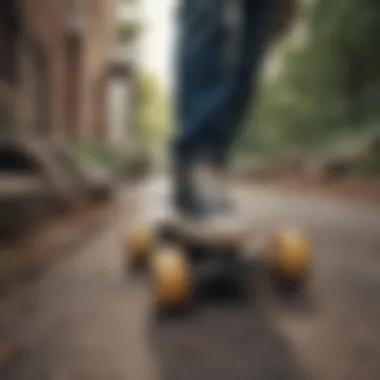

"Skitching perfectly encapsulates the quest for thrill in skateboarding, echoing the same spirit that pushed surfers to the sidewalks.”
Despite its somewhat reckless allure, skitching is laden with social and ethical considerations. Discussions have emerged about safety, respect for drivers, and the potential consequences of such activities. As skitching continues to evolve, understanding its roots sheds light on its place in the broader skateboard community, offering insights into how this daring technique has taken shape over the years, intertwined with the very identity of skateboarding itself.
In summary, skitching stand at a challenging intersection of excitement and responsibility. To fully appreciate and engage with this practice, one must grasp its basics, delineate its history, and navigate the cultural significance of this adventurous form of skateboarding.
The Technique of Skitching
Skitching is more than just a technique; it's an art form. It blends skill and thrill, enabling a rider to maneuver fluidly in urban spaces while adding an element of style. By understanding this technique, skaters can tap into the essence of skitching, which represents the very spirit of skateboarding. When one engages in skitching, they are not merely riding a board; they are becoming part of a living tapestry of culture and creativity that defines skateboarding.
Essential Skills Required
To successfully master skitching, a skater must possess certain core skills. Foremost, balance is crucial. Without a steady center of gravity, a skater will find themselves tumbling more often than not. Additionally, good reflexes come into play. As the rider whizzes through city streets, they must respond quickly to sudden obstacles and shifts in momentum.
In terms of technique, the following skills are particularly beneficial:
- Steering Control: Fine control over the board is essential for navigating tight corners and reacting to car movements.
- Speed Regulation: Learning to speed up or slow down smoothly prevents mishaps and ensures a more controlled ride.
- Situational Awareness: Being aware of surroundings, including traffic and pedestrians, is vital for safety.
These foundational skills are what set apart competent skaters from those who simply dabble in the style.
Body Positioning and Balance
Body positioning plays a pivotal role in skitching. A athlete's stance can make or break a successful run. Keeping the knees slightly bent helps absorb shocks from bumps in the road. Also, leaning slightly forward aids in stabilizing the skater's body, particularly at higher speeds.
To achieve optimal balance:
- Feet Placement: Position feet shoulder-width apart on the board. This provides a stable base.
- Hips and Shoulders Alignment: Aligning the hips and shoulders with the board keeps the center of gravity low and centralized.
- Head Up: An open posture allows for better vision of what's ahead and enhances overall awareness, promoting faster reaction times.
Skaters who master their balance often find that they can maneuver with greater agility, making skitching a more seamless part of their riding experience.
The Role of Momentum
Momentum is the unsung hero in skitching. Unlike casual skateboarding, skitching relies heavily on the inherent speed generated by moving vehicles. It’s this relationship that can lead to thrilling rides, provided it is handled with a sense of responsibility.
A few key points about momentum in skitching include:
- Ride Responsibly: It’s crucial to harness this momentum without overtaking the capabilities of control. Skaters should practice in safe environments first.
- Understanding Acceleration: Knowing how much push to apply can help a skater maintain their speed without losing control.
- Using the Wind: Catching the wind can improve speed during skitching. Leaning to one side or another can also affect how a skater catches that breeze, influencing their overall speed.
"Momentum is like a dance partner; it's best when you both know the steps and move together in harmony."
In summary, mastering the technique of skitching involves a careful concentrate on balance, skill, and momentum. As the sport grows more popular, being adaptable and aware of surroundings can make all the difference.
Safety Considerations in Skitching
When it comes to skitching, safety shouldn't take a backseat. While the adrenaline rush might tempt skaters to throw caution to the wind, understanding the safety considerations involved can make the difference between a thrilling ride and a painful spill. This section delves into the potential risks skaters might face when skitching and the importance of wearing protective gear to mitigate those dangers.
Potential Risks Involved
Skitching, while exciting, comes with its own share of perils. It's essential to recognize these risks to practice the technique responsibly. Here are several hazards that skaters should keep in mind:
- Loss of Control: Moving at high speeds can lead to an inability to steer or brake effectively. Sudden movements from the towing vehicle can exacerbate this situation, causing falls.
- Collision: There's always a chance of colliding with an obstacle, be it pedestrians or vehicles. Skaters must maintain awareness of their surroundings to avoid dangerous interactions.
- Injury from Falling: In cases where a skater loses balance, the resulting fall can lead to serious harm. Common injuries include sprains, cuts, or even fractures.
- Environmental Factors: Pavement conditions, weather, or unexpected road hazards can dramatically alter the skitching experience. A slick surface after a rain can be treacherous.
"Understanding the risks involved in skitching is the first step to enjoying this thrilling activity responsibly. A little caution can go a long way."
Protective Gear Recommendations
Taking the necessary precautions can help skaters enjoy skitching while minimizing risks. Here are some recommendations for protective gear that every skater should consider:
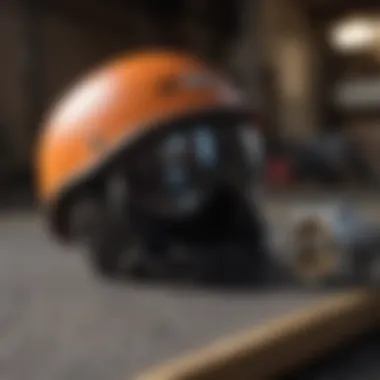
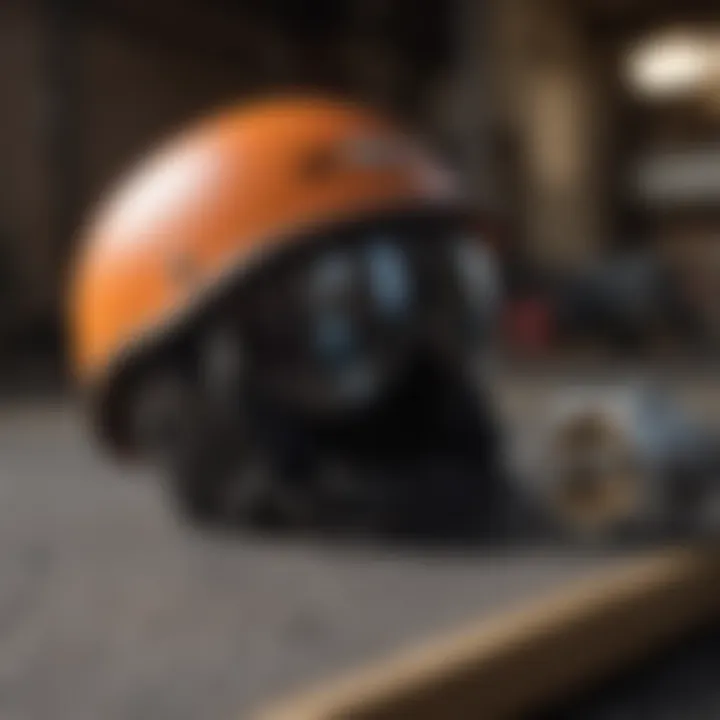
- Helmet: Always wear a good-quality helmet. It protects the most valuable asset—your noggin.
- Knee and Elbow Pads: These pads can significantly reduce the impact of falls. They help cushion any blows to your joints.
- Wrist Guards: Protecting the wrists is crucial, as they are often the first point of contact when falling. Good wrist guards can prevent breaks and sprains.
- Skate Shoes: Wearing proper footwear not only provides better grip on the board but also supports the ankles.
By adopting these safety measures, skaters can ensure that their skitching experience remains enjoyable, blending thrill with responsibility.
Cultural Context of Skitching
The practice of skitching, while seemingly a simple act of grabbing onto a moving vehicle while riding a skateboard, goes beyond mere thrill-seeking. It serves as a fascinating intersection between historical significance and contemporary culture within the skateboarding community. Understanding the cultural context of skitching adds layers of meaning to the activity, shedding light on its influence on the identity of skaters and their interactions with urban landscapes.
Skitching in Skateboarding History
Skitching dates back to the early days of skateboarding, rooted in a culture that embraced creativity and rebellion. Originally, it was popularized by younger riders who sought out new ways to elevate their experience on the streets. Rather than just slicing through empty pavement, skitching offered an adrenaline-packed method to navigate urban environments, turning mundane commutes into exhilarating adventures.
As skateboarding evolved through the decades, skitching found its place within the broader narrative. Throughout the 1970s and 1980s, the rise of skateboard tricks and street style propelled skitching into the limelight, contributing to the development of skate culture. This was a time when young riders not only expressed themselves through tricks but also their relationship with movement and their surroundings.
"Skitching isn’t just about the ride; it’s a statement about freedom and creative expression in a world that often demands conformity."
The documentation of skitching in skateboarding history can be spotted in skate magazines and videos, where daring skaters showcased their skills while skitching behind cars or buses, forging a connection between the skateboarding community and urban life.
Skitching and Urban Exploration
Urban exploration is an important theme tied to skitching, embodying a spirit of adventure and discovery. When skaters grab hold of a moving vehicle, they engage with the city in a unique way, one that embodies a form of playful engagement with their environment. This relationship with the urban landscape allows riders to traverse distance quickly, revealing hidden gems of their surroundings that they might otherwise miss while on foot or waiting for public transportation.
Moreover, skitching promotes a sense of community among skaters. These spontaneous rides often involve shared experiences, where groups of friends connect through the thrill of the moment. They bond over their escapades and develop mutual respect for the risks involved in their riding style.
However, this practice also raises questions around safety and legality. Skaters must navigate the intricacies of urban life while respecting both traffic laws and the rights of others. Thus, skitching continues to exist in a nuanced space, blending the excitement of exploration with the responsibility of sensible riding.
In summary, skitching is far more than an adrenaline rush. It’s interwoven with the history of skateboarding and urban culture, shaping the perspectives of skaters who engage in this form of expression. The act serves as both a mode of transportation and a testament to the ethos of freedom, creativity, and community that underpins skateboarding as a whole.
Comparative Analysis: Skitching vs. Other Skateboarding Styles
Skitching occupies a fascinating niche within the broader landscape of skateboarding styles. It offers a unique blend of thrill, technical skill, and cultural expression that sets it apart from other techniques such as cruising, street skating, or vert skating. In examining this topic, we can uncover not only the distinct technical elements inherent to skitching but also how it resonates culturally compared to other styles.
Technical Differences
At its core, skitching integrates the act of holding onto a moving vehicle while balancing on a skateboard. This contrasts sharply with more traditional skateboarding styles which prioritize self-propulsion and tricks. While a street skater may execute a flawless Ollie or kickflip, a skitcher relies on external momentum—often from cars or other vehicles—to achieve speed.
Considering this, the most notable technical differences include:
- Speed Generation: In skitching, the thrust is derived from a vehicle, whereas street or vert skating focuses primarily on manual effort.
- Weight Distribution: Skitchers must constantly adjust their balance and weight distribution to maintain control during high-speed rides. This variable balance differs from the more predictable patterns observed in standard skating techniques.
- Trick Execution: While street skaters combine flips and rotations into their routines, skitchers tend to incorporate opportunistic tricks based on speed and environment, showcasing adaptability rather than mere technique.
Many skaters argue that these technical differences reflect a simple yet profound shift in approach. Traditional skateboarding is grounded in self-contained mastery, while skitching challenges riders to engage with their environment creatively and responsively.
Cultural Significance in Different Styles
The cultural implications of skitching versus other skateboarding styles reveal a rich tapestry of community values and expressions. As skitching features a relationship with motor vehicles, it frequently teeters between admiration and criticism within the skate community. Some argue skitching embodies a reckless spirit of adventure, while others see it as an irresponsible act that endangers both the skaters and drivers.
In contrast, styles like street skating often champion innovation rooted in city landscapes. They embrace the urban environment as a playground for creativity, encouraging skaters to repurpose architectural elements. The cultural narratives surrounding these styles can diverge significantly:
- Community Engagement: Skitching can introduce skaters to spontaneous interactions with the public. Such encounters can foster a sense of kinship among those who appreciate the excitement of the ride.
- Identity Formation: Many skaters find their identity through their chosen style. While vert skaters might be admired for athleticism and precision, skitchers can gain notoriety for their daring escapades and street smarts.
- Ethical Discussions: Skitching raises various ethical questions that are often absent from other skateboarding forms. Discussions around legality, safety, and risk-taking fuel debates within the community, shaping the social fabric of skitching enthusiasts.
"Skitching isn't just about the ride—it's about the stories we tell, the risks we take, and the relationships we form along the way."
In summary, as we draw a line through skitching and other skateboarding styles, it becomes clear that every approach carries its own technical elements and cultural narratives. These differences not only reflect the diverse preferences of skaters but also highlight the broader conversation within the skateboarding world about risk, identity, and community.
Personal Stories from the Skate Community
Skitching, often seen as a daring dance between thrill and recklessness, is deeply woven into the narrative of many skateboarders. Personal stories from the skate community play a crucial role in highlighting the human side of this technique. Through these tales, one gains a broader understanding of how skitching not only influences the sport but also shapes the identities of skaters. The gravity of these experiences often paints a vivid picture of both the exhilarating highs and sobering lows.
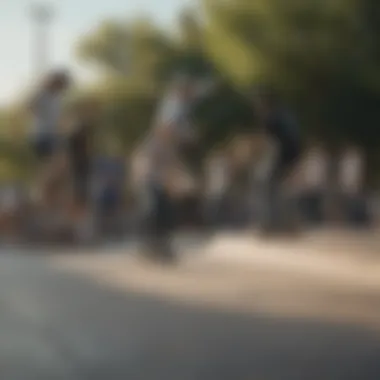

Skaters' Experiences with Skitching
Skaters have left their marks on the streets, with each skitch having a story of its own. Whether it's a sunset ride down the boulevard or a late-night dash alongside a city bus, these experiences form lasting impressions. For instance, consider a skater named Max, who recalls the first time he confidently skitched off a friend's longboard. "I felt like a bird soaring,” he says, reflecting on the feeling of being pulled by the speed of the vehicle.
Max’s tale echoes a sentiment heard throughout the community: the rush of skitching brings a unique blend of freedom and excitement. Interviewing various skaters unveils a multitude of experiences, from exhilarating close calls with traffic to the inseparable bond created while skitching in a group. It’s not just about the act; it's about the camaraderie, the shared laughs, and at times, the lessons learned.
Moreover, the stories often expose the raw edges of this practice. Many skaters also share cautionary tales. For example, Jake, an avid skater, recounts his early encounters where he miscalculated his balance and found himself in some tight spots—literally. "You learn pretty quickly, either adapt or eat asphalt," he jokes, illustrating how trial and error is part of the journey.
These personal anecdotes serve not just as entertainment but as valuable learning experiences for others. They provide anecdotal evidence on the importance of understanding one's surroundings and respecting the responsibilities that come with the thrill of skitching.
Impact on Rider Identity
Rider identity, a concept that encapsulates how skaters see themselves and relate to others, is greatly affected by experiences with skitching. For many, it transcends the act itself, transforming into a badge of honor among peers.
When skaters talk about their first successful skitch or radical move, there is often a shift in their self-perception. Skitching can become a litmus test of sorts, where mastering this activity signifies a rite of passage in skate culture. The thrill and allure of daring techniques bring a sense of pride.
Within the community, skitching can often lead to an internal dialogue about risk-taking. Riders who embrace skitching might view themselves as adventurous or rebellious, pushing boundaries that others might avoid. This portrayal can resonate deeply, influencing not just how they see themselves on a board, but also how they navigate the world outside skating.
In essence—skitching is more than just a technique; it shapes how riders see themselves and their place within the broader community. Stories revolving around it enrich this identity, openly stirring a conversation about the balance between thrill and responsibility.
"Skitching is dangerous, but it also teaches you about trust, control, and your own limits. It's a dance with the unknown, and those moments define who you are on the board."
– Anonymous Skater
The Future of Skitching in Skateboarding
The world of skateboarding is not static; it evolves with the whims and creativity of its practitioners. Skitching, a technique that has long been intertwined with the skateboard culture, is no exception. It's like a river that flows, shaped by both the environment and the forces that drive it. Understanding the future of skitching is crucial, as it reflects broader trends in skateboarding and urban mobility.
Key to envisioning this future is recognizing how skitching serves as a bridge between traditional skateboarding and new-wave riding styles. In a society where instant gratification is often the name of the game, skitching remains a captivating method for thrill-seekers, offering a unique blend of risk and skill. The challenge lies in balancing this excitement with the responsibility that comes from engaging in a behavior often perceived as reckless.
Evolving Techniques and Styles
As riders push their limits, techniques in skitching continue to evolve. What began as a casual hang on to a moving vehicle has morphed into a nuanced practice that involves precise body movements and an acute awareness of surrounding environments. For example, some skaters are now experimenting with hybrid styles that incorporate elements from longboarding and bmx, resulting in fresh expressions of skitching that appeal to varied audiences.
New schools of thought within the skater community emphasize adaptability; skaters are learning to seamlessly blend skitching with tricks from other disciplines. This trend is not merely about executing flashy rides but also about embracing the culture of creation.
Here are some techniques that skaters are beginning to adopt:
- Dance Skitching: Combining fluid dance movements with skitching maneuvers, allowing for aesthetic flair.
- Side Skitching: Riding alongside the vehicle rather than directly behind, providing a different perspective on both technique and safety.
- Team Skitching: Collaborating with others to create visually striking skitching patterns.
These evolving techniques provide a fascinating look into how skitching continues to adapt. In this way, skitching isn't just static; it’s like a canvas that is being painted over every time a new trick or technique is tried.
Impact of Technology on Skitching
Tech advancements have the potential to reshape skitching significantly. Imagine skateboarders outfitted with smart gear that offers real-time data on speed, balance, and even environmental conditions. This emerging technology promises to enhance rider safety while elevating the adrenaline factor of skitching.
Smart wheels and sensors could alert riders to the proximity of other vehicles or indicate an unsafe speed when skitching. Drones might also be utilized to film runs from above, providing a new way to capture skitching moments—sharing exhilarating footage with community members online.
Moreover, online platforms allow skaters to share ideas, experiences, and techniques more easily than ever before. As a result, skitching could gain newfound visibility within the broader skate community, enhancing its reputation and drawing in more participants.
Finale
In closing, this exploration of skitching on a skateboard underscores its significance within the larger skateboard culture, connecting all the threads laid out in previous sections. It’s not just about the thrill, but also the diverse experiences and technical skills involved. Skitching invites individuals into a dialogue about community values, street ethics, and the very essence of adrenaline-fueled rides.
Recap of Key Points
- Definition and Origins: Skitching is rooted in the historical practices of skateboarding, evolving into both a technique and a cultural phenomenon.
- Technique: Mastering this art requires an understanding of balance, body positioning, and the critical use of momentum.
- Safety Considerations: Engaging in skitching poses certain risks, necessitating the use of protective gear to mitigate potential injuries.
- Cultural Context: The role of skitching is not only technical but rich in narrative, reflecting the community’s ethos and its relationship with urban exploration.
- Future Directions: As skateboarding continues to evolve, so do techniques like skitching, especially with the advancing role of technology in sports.
Final Thoughts on Skitching's Role
Ultimately, skitching serves as a bridge that connects adrenaline junkies to their surroundings, allowing skaters to experience the world at a different speed. This activity challenges conventional ideas of what skateboarding represents, embracing a side of playfulness that fuels creativity on wheels. Recognizing its impact reaffirms skitching’s place in the ongoing evolution of skate culture, encouraging both newcomers and veterans to reevaluate their relationship with this compelling form of expression.
"Skateboarding is an art, and skitching is one of the brushes we use to paint our experience on the urban canvas.”
In sum, understanding skitching not only enhances one’s skills but also deepens the appreciation for the culture that surrounds skateboarding.







